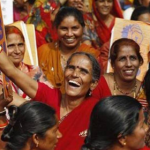When Bhutan hosted the first-ever international conference on gross national happiness, in the spring of 2004, many of the western delegates represented start-ups in the business of measuring happiness. The ‘happiness industry’ has now taken centre stage.
Since 2012, the United Nations (UN) has commissioned an annual world happiness report which ranks countries on the basis of gross domestic product (GDP) per capita, life expectancy, and polling data on how much social support and freedom people feel they have to make life choices. Some of the data produced by this survey appears counter-intuitive: for instance, Somalia’s happiness ranking at 76 is higher than both China’s, at 83, and India’s, at 118.
This anomaly is best illustrated by juxtaposing the Happiness Report (HR) rankings of some countries with their ranking on the UN’s Human Development Index (HDI). South Africa is the only country that has the same score–116th–in both the HR and HDI. Many countries rate higher than India on the HR but rank much lower on the HDI (see table). Bhutan, for example, features at a low 132nd place in the 2015 HDI while it ranks 84th in the HR ranking.
The reason for such skewed data is that while the HR and HDI both account for life expectancy and per capita income, HR focuses more on people’s perceptions.
Every year, HR researchers ask a sample group of 1,000 people in each of the 157 countries it covers to respond to a set question: “Please imagine a ladder with steps numbered from 0 at the bottom to 10 at the top. The top of the ladder represents the best possible life for you, and the bottom of the ladder represents the worst possible life for you. On which step of the ladder would you say you personally feel you stand at this time?” Each country’s HR ranking is determined by an average of life evaluation scores it receives, correlated with the average received in the previous three years.
Such surveys are based on the premise that measuring people’s perception of the quality of life is key to assessing the progress of societies. For instance, in 2013 the Organisation for Economic Co-operation and Development (OECD) published Guidelines on Measuring Subjective Well-being covering 11 domains of well-being, including jobs, health and housing, civic engagement, and the environment[1].
Nonetheless, happiness research remains somewhat contentious with many disputes over methodology and the parameters that deserve to be measured. This may be why the UN maintains an arm’s length distance from its happiness reports. This year’s report carries the following disclaimer: “The World Happiness Report was written by a group of independent experts acting in their personal capacities. Any views expressed in this report do not necessarily reflect the views of any organization, agency or program of the United Nations.”[2]
One way to understand the limitations of the HR is to contrast it with the Happy Planet Index (HPI) compiled by the New Economics Foundation, a private non-profit think tank based in London.
While the HR’s primary focus is on subjective happiness, the HPI, which was last compiled in 2012, is more expansive. It takes Gallup Poll data on experienced levels of well-being for each country, multiplies that with the life expectancy rate in the country, and then divides the figure arrived at by the country’s ecological footprint. Most countries that rank high on both HDI and HR–such as the United States, Denmark, and the United Kingdom–do poorly on the HPI, mainly on account of their enormous ecological footprint.
Bhutan, which strangely was left out of the HPI, remains the lone country to have created a metric that is more holistic than GNP, HR, HDI, and HPI combined. Its gross national happiness (GNH) measure is based on monitoring nine domains – psychological well-being, standard of living, good governance, health, education, community vitality, cultural diversity and resilience, time use, and ecological diversity and resilience.[3]
Bhutan’s ongoing experiment with GNH is far from perfect, both in terms of measurement methodology and how it intersects with the growth of the economy. However, it does serve as a beacon for politicians and policymakers who understand that GNP is a misleading measure of the state of a nation or its long- term prospects.
Policymakers who set up systems to internally monitor the nine domains which make up the GNH can happily ignore the pollsters of the happiness business and the global rankings of their surveys.
| Various | Happiness | Rankings | |
| Country | Happiness Report 2016* | HDI 2015** | Happy Planet Index 2012*** |
| India | 118 | 130 | 32 |
| Pakistan | 92 | 147 | 16 |
| Bangladesh | 110 | 142 | 11 |
| South Africa | 116 | 116 | 142 |
| Ethiopia | 115 | 174 | 94 |
| Brazil | 17 | 75 | 21 |
| Russia | 56 | 50 | 122 |
| China | 83 | 90 | 60 |
| Bhutan | 84 | 132 | — |
| U.S.A | 13 | 8 | 105 |
| UK | 21 | 14 | 41 |
| Denmark | 1 | 4 | 110 |
*Ranking by World Happiness Report
**Ranking by Human Development Index 2015
**Ranking by Happy Planet Index
Rajni Bakshi is Gandhi Peace Fellow, Gateway House.
This article was exclusively written for Gateway House: Indian Council on Global Relations. You can read more exclusive content here.
For interview requests with the author, or for permission to republish, please contact outreach@gatewayhouse.in.
© Copyright 2016 Gateway House: Indian Council on Global Relations. All rights reserved. Any unauthorized copying or reproduction is strictly prohibited.
References
[1] Organisation for Economic Co-operation and Development, OECD Guidelines on Measuring Subjective Well-being, 20 March 2013,<http://www.oecd.org/statistics/oecd-guidelines-on-measuring-subjective-well-being-9789264191655-en.htm>
[2] World Happiness Report, World Happiness Report 2016, Volume 1, <http://worldhappiness.report/wp-content/uploads/sites/2/2016/03/HR-V, 1_web.pdf, p 1.>
[3] Gross National Happiness, Nine Domains,<http://www.grossnationalhappiness.com/nine-domains/>


